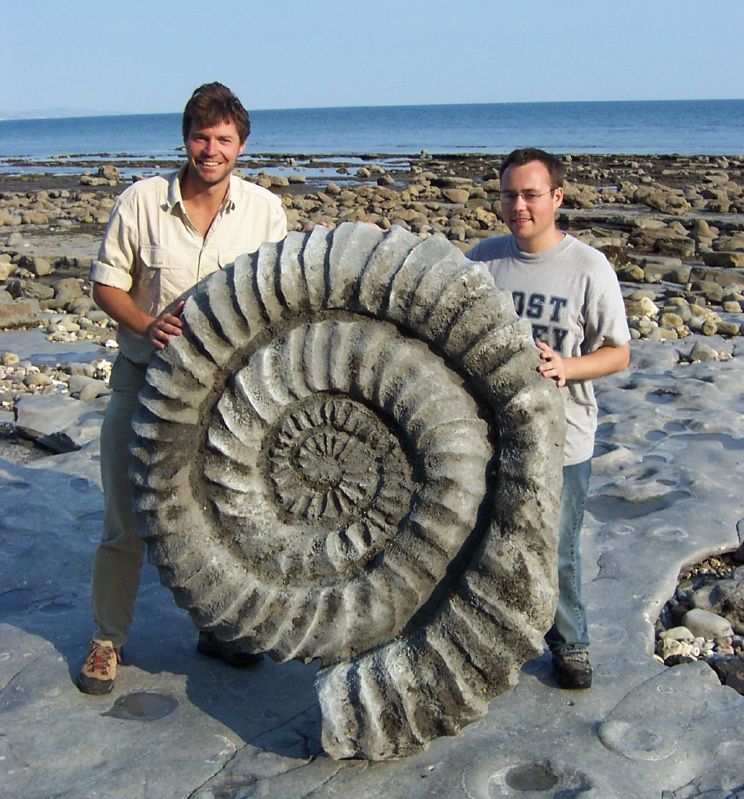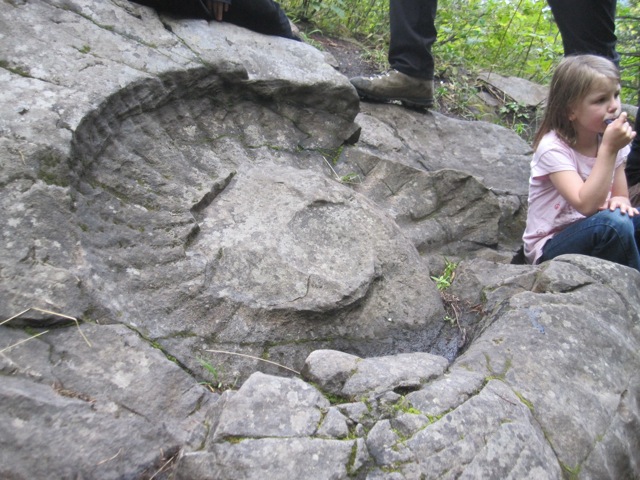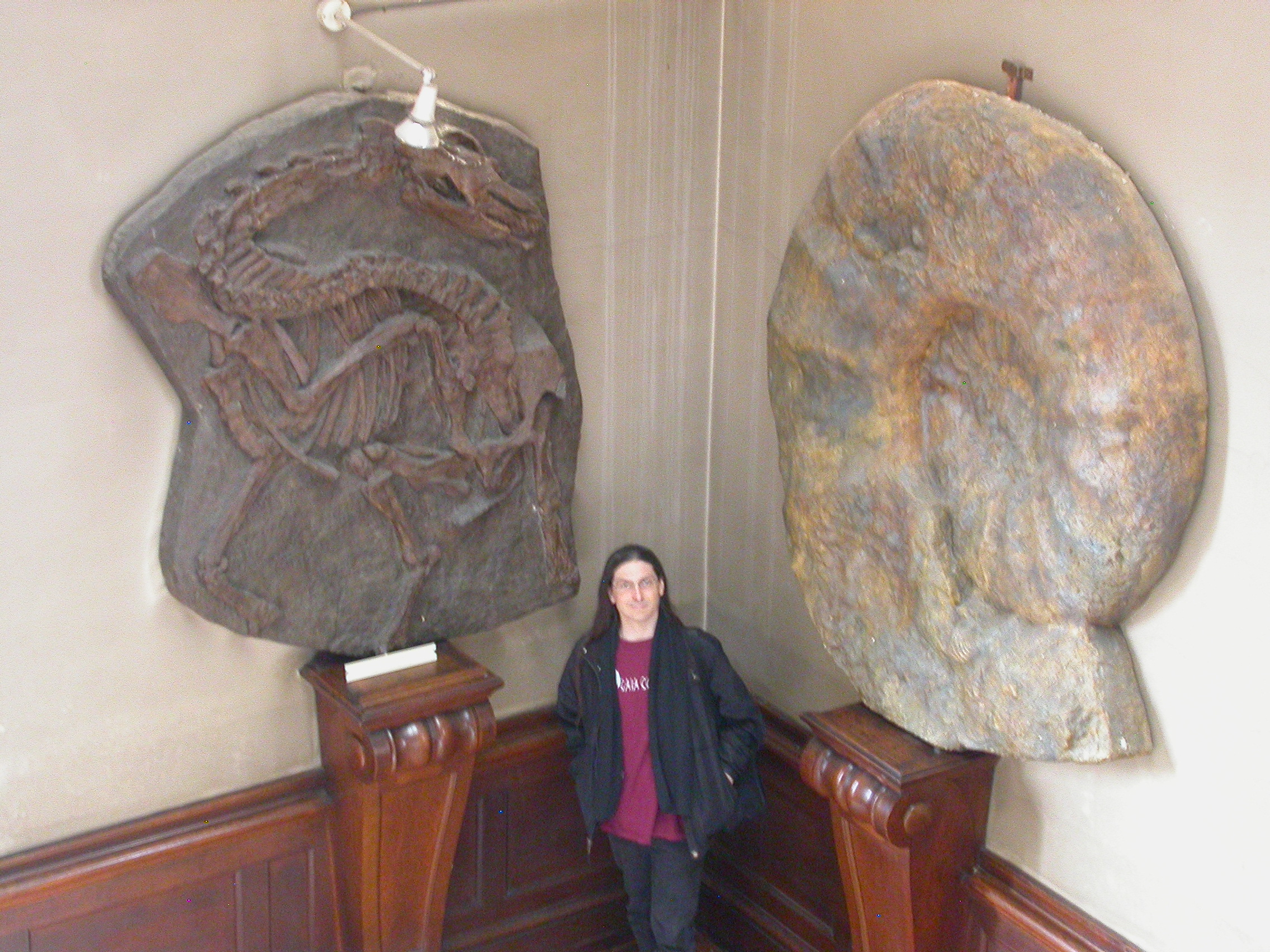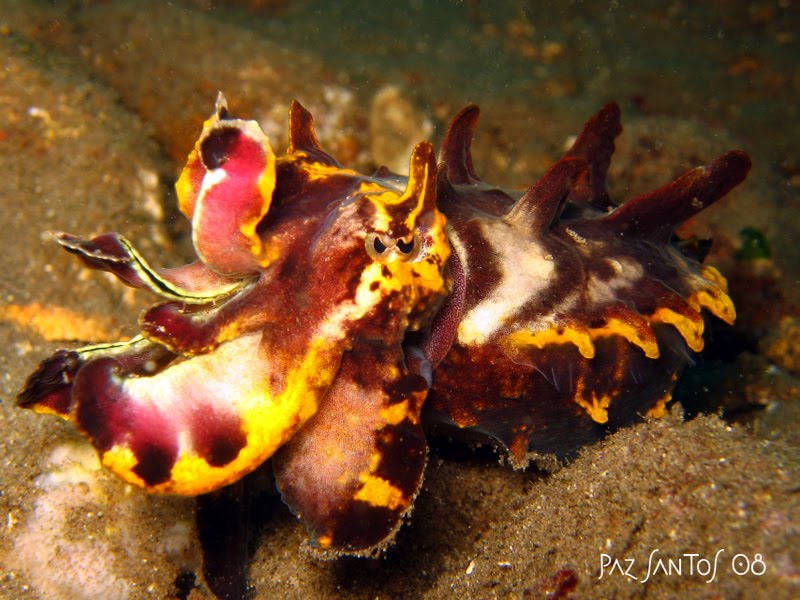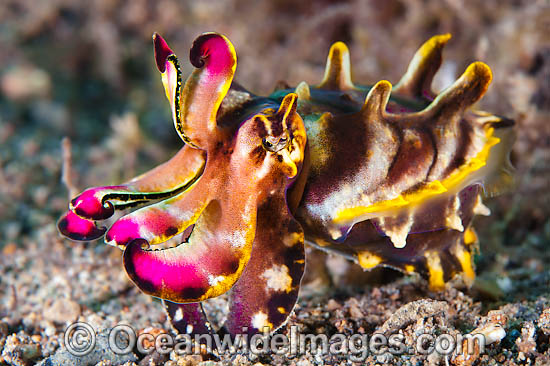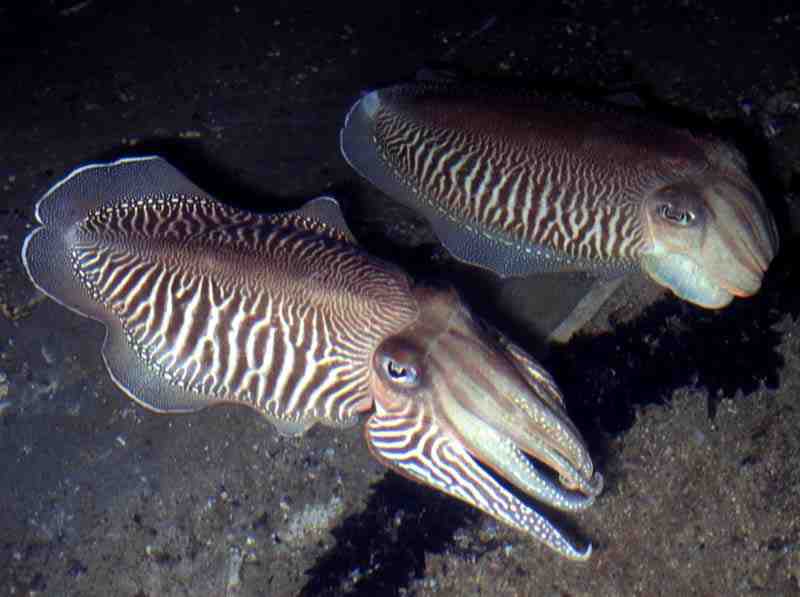You are currently browsing the tag archive for the ‘cephalopod’ tag.

Last week I finished up the AtlasObscura course on cephalopods, a Zoom mini-survey of this astonishing class of mollusks. The course was a delightful romp through morphology, taxonomy, paleontology, and ecology and featured some virtuous side lessons about how to protect Earth’s ecosphere (and ourselves).
The incredible diversity, beauty, and wonder of cephalopods reminded me that I have not blogged about them…or any molluscs…or anything else for far too long. Ergo, as a promise of more posts to come, here are two little cephalopod drawings I made to share with the class.
The first picture (top) is an Indo-Pacific cuttlefish enjoying the reef and trying to overlook the whimsical Thai/Malay merman who has appeared out of the realm of fantasy (note also the reef shark, giant clam, and mantis shrimp). The second image (as per “homework” instructions) is a cooperoceras flashing iridophores which it may or may not have had as various lower Permian sea creatures (most notably Helicoprian) look on in dazzled envy.
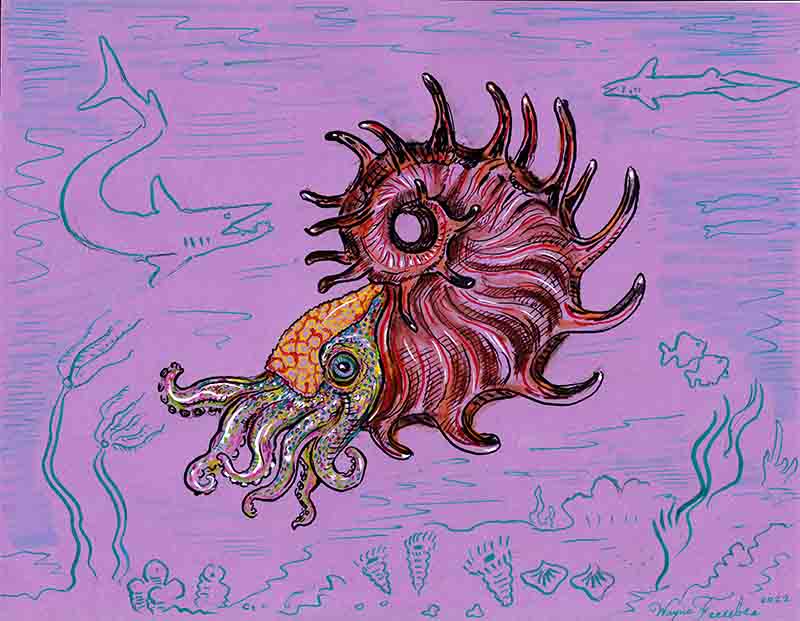
We will talk more about these creatures in weeks to come (and maybe more about the Permian too, since I keep thinking about how the Paleozoic ended), but for now just enjoy the little tentacled faces! Also, it is “inktober” and I have been obsessed with classic pen and ink, so maybe get ready for more drawings as well (to say nothing of our traditional Halloween theme week, which will be coming up quite soon).
The kraken is a giant sea monster from Norwegian and Icelandic lore. Various sailors who wrote epics from the golden age of northern exploration along the coasts of Iceland and Greenland described vast beings, larger than whales. The Örvar-Odds saga from the 13th century describes a being so large that it could be mistaken for a land mass. Its jaws looked like headlands and its teeth like rocks, yet it was capable of submerging and rising. The monster was dangerous for causing great whirlpools which could swallow ships.
Such bizarre sightings might be attributable to the vagaries of weather (or the treacherous volcanic nature of Iceland—where lands do indeed rise and sink), yet sometimes whales would be seen fighting with giant arms. Indeed occasionally  these arms would wash ashore. Living in a dangerous and superstitious profession, sailors kept the stories of a huge boat-sinking monster alive.
these arms would wash ashore. Living in a dangerous and superstitious profession, sailors kept the stories of a huge boat-sinking monster alive.
Carl Linnaeus, the father of modern taxonomy and biological classification, took these sailor’s tales seriously enough to classify the kraken as a cephalopod in his first edition of Systema Naturae (published in 1735), however subsequent editions omitted the animal. Various eighteenth and nineteenth century armchair natural scientists kept stories of the animal alive, until modern marine biologists untangled the myth from the (even stranger) realities of the giant squid and the colossal squid.

Today the kraken has moved definitively into the realm of unicorns, leprechauns, quilins, and other mythical creatures, but its popularity has not been affected. The huge squid monster haunts pirate movies and fantasy oceans all while selling rum and fending off the latest Hollywood heroes in CG animation. In fact the beast has even scaled the pinnacles of literary fame. The Kraken by Lord Alfred Tennyson is an irregular sonnet which describes the benthic monster in language which a poetic merger of Victorian gardening and Lovecraft horror. The monster sleeps in the depths of the ocean awaiting the day of revelation! Here is the poem in its entirety:
Below the thunders of the upper deep;
Far, far beneath in the abysmal sea,
His antient, dreamless, uninvaded sleep
The Kraken sleepeth: faintest sunlights flee
About his shadowy sides: above him swell
Huge sponges of millennial growth and height;
And far away into the sickly light,
From many a wondrous grot and secret cell
Unnumber’d and enormous polypi
Winnow with giant arms the slumbering green.
There hath he lain for ages and will lie
Battening upon huge seaworms in his sleep,
Until the latter fire shall heat the deep;
Then once by man and angels to be seen,
In roaring he shall rise and on the surface die.

A few weeks ago Ferrebeekeeper featured a post about belemnites, extinct cephalopods from the Mesozoic which teemed in immense schools through the reptile-haunted oceans of that bygone era. Yet belemnites were certainly not the only cephalopods which swam in the Mesozoic seas. Numerous shelled cephalopods—the ammonites—were widespread in every sort of marine habitat. Ammonites are personal favorites of mine so I am not going to write a comprehensive explanation/description of the subclass. Instead I wish to provide you with an idea of how big ammonites could get by providing a few pictures of large ammonite fossils which have been discovered. Imagine these monsters jetting through the water with huge tentacles and big intelligent eyes scanning for giant predatory reptiles and you will have a better idea of the Mesozoic Oceans!
When I was a child, my family went to the invertebrate house in Washington, DC. Upon entering the building, there was a very beautiful aquarium which contained the most alien creature I have ever encountered. It was a beautiful glistening red…and then it instantly changed color to bright white with pale dun spots. Next the strange being sank through the water column and changed color and texture. Its smooth skin knotted up into ropey bumps. The speckled white tuned to wavy deep brown lines. Intelligent eyes with W-shaped pupils regarded me from what suddenly seemed to be a hunk of rock. I had encountered my first live cuttlefish. In fact there were two in the tank, as I discovered when a patch of unremarkable sand changed shape and color and jetted to the surface while flashing rainbow colors. They were worked up because they were about to be fed and, when eating their suppers, the cuttlefish put on a particularly good show. They changed color like digital screens and waved their eight arms about and then ZAP! elongated feeding tentacles shot out from under their mantles to grab the anchovies from across the length of the tank. Then they rocketed around with uncanny torpedo speed.
Cuttlefish are cephalopods like octopuses, argonauts, squid, and nautiluses. Across the long ages they have descended from those magnificent nautiloids and othocones who ruled the world during the Ordovician era. Cuttlefish are one of the most intelligent invertebrates: their brains make up a substantial portion of their body mass, and their behavior when hunting, hiding, and courting is complex. The unusually shaped eyes of the cuttlefish are among the finest in the animal kingdom. Their blood makes use of copper rather than iron to fix oxygen so it runs green. All cuttlefish possess poisons in their saliva. In fact the Pfeffer’s Flamboyant Cuttlefish is as toxic as the Blue-ringed octopus.
But why am I talking about these extraordinary mollusks during a week devoted to blogging about color? First of all cuttlefish are “the chameleons of the sea.” As I observed at the zoo, they can change color with a speed and facility unrivaled by any other creature. They use their mastery of color to camouflage themselves, to hunt, and to communicate with each other. The animal’s existence literally hinges around the color-changing chromatophores in their skin. But the association of cuttlefish and color doesn’t stop there. Cuttlefish produce a dense ink which they squirt into the ocean to disguise their movements when frightened. This sepia ink, collected from the ink-sacks of common cuttlefish destined for the table, was prized for writing and for drawing during the classical era. Many of the great histories and literary masterpieces of Greco-Roman thought were first penned in sepia ink. Although other inks took the place of sepia for writing, it maintained its place in the artist’s studio up until the late nineteenth century when it was supplanted by synthetic pigments.
This means that many of the masterpieces of draftsmanship were also created with sepia ink. A particularly effective and pleasing style was to sketch something in watered down sepia washes and finish the details with black india ink. Like chartreuse, magenta, and vermilion, the name sepia itself has become synonymous with a color. This reddish brown is famous in old masters pen-and-ink drawings, antique photos, and memory-hazed movie flashbacks. Not only has this ink provided some of the most beautiful drawings in history, recent studies have shown that cephalopod ink is toxic to certain cells—particularly tumor cells, so we may not have written the last concerning sepia ink.
The paper nautilus, aka the argonaut (family Argonautidae) bears an uncanny resemblance to the majestic nautiloids of yore. This resemblance becomes bizarre when one realizes that the resemblance is superficial. The paper nautilus is no nautiloid at all.* It is in fact an octopus. Its shell is not a true shell manufactured within an internal shell sack (as in other mollusks), but is rather an egg case secreted and delicately assembled by the female. It is as though, instead of having a protective skeleton from birth, you were expected to build one and hatch your young inside of it.
Argonauts are pelagic predators, hunting planktonic mollusks, minnows, and small octopi and squid. Like other cephalopods, they can change colors and alter their shape. They move by means of jet propulsion. Argonauts exemplify one of the most formidable traits of the cephalopod: intelligence. To quote Marcie Orenstein’s Marine Animals of Bermuda, “These animals often form associations with gelatinous marine species, utilizing them for food, locomotion, and protection.” For example Argonauts are often found clutching the top of jellyfish and steering the latter around the ocean. The Argonaut eats through the jellyfish’s mantle into its digestive tract. It can thereafter rely on the jellyfish’s tentacles as a sort of fishing apparatus with which to catch prey (which it takes from inside the jellyfish’s gastral cavity). The jellyfish further serves as a protective shield, for the argonaut’s predators, such as tuna and dolphins, tend to shun such hydrozoans. Additionally the Argonaut gets a free ride for as long as its jellyfish remains alive.

We have pictures of this behavior! Argonauta argo atop the jellyfish, Phyllorhiza punctata. Photographs Copyright ©, Thomas Heeger, University of San Carlos, Philippines.
I mentioned above that only female argonauts build shells. The male is a strange armorless dwarf, a tenth the size of the female. One of the male argonaut’s arms, the hectocotylus, is specialized for mating. The Tree Of Life Argonaut webpage describes this process, “At mating, the hectocotylus, which carries one large spermatophore, breaks out of its sac and then from the male body. The free hectocotylus invades, or is deposited in, the female’s mantle cavity, where it remains viable and active for some time.” Georges Cuvier first discolvered the hectocotylus but mistakenly described the organ as a worm parasitic on the female argonaut.

Georges Cuvier's original illustration of the Hectocotylus of an Argonaut (Iconographie du règne animal de G. Cuvier, 1829)
The paper-thin calcareous shell of the female argonaut is truly an egg case. It is shaped in a Fibonacci spiral for reasons which are unclear, however, like a nautiloid’s shell, it contains a bubble of air which the adult female nautilus manipulates for buoyancy. Aristotle wrote that the Argonaut used its egg case and its flattened tentacles to catch the wind and sail, however there is no current evidence of such behavior (although cephalopods travel all sorts of strange ways). When the eggs grow large in the shell case and hatch, the female is pushed out of her egg case and she dies. Marianne Moore very beautifully described the female argonaut’s maternal solicitude in her poem The Paper Nautilus (while additionally cross-referencing the hydra, which we love at this blog). Moore describes the female argonaut as a metaphor for creativity:
for she is in
a sense a devil-
fish, her glass ram’shorn-cradled freight
is hid but is not crushed;
as Hercules, bitten
by a crab loyal to the hydra,
was hindered to succeed,
the intensively
watched eggs coming from
the shell free it when they are freed
(From The Complete Poems of Marianne Moore. Copyright © 1961 Marianne Moore)
*Of the shelled nautiloids which once ruled earth, which teemed in countless numbers through the oceans of the Paleozoic and the Mesozoic, exactly one species is left–the magnificent pearly nautilus, concerning which, more anon.

A diorama portraying the seas of the Ordovician Period (from the Exhibit Museum, University of Michigan)
The Ordovician Period, the second period of the Paleozoic Era, took place from 488 to 444 million years ago. During those 44 million years, the landmasses of earth were devoid of life except for hardy lichens, tiny algae, and a few lowly non-vascular plants. The oceans, however, teemed with diverse marine invertebrates and primitive vertebrates. The ecosystems of these great shallow seas seem familiar–with colorful intermeshed filter feeders, grazing herbivores, and swift deadly predators. And yet the creatures are so alien as to make Ordovician reconstructions almost resemble another planet. All of the creatures of a modern coral reef are replaced by strange analogs: the dominant filter feeder were not corals but weird sponge-like animals—the archaeocyathids. The grazers were conodonts and trilobites. The predators were primitive sharks, huge scorpion-like eurypterids, and above all, the nautiloids–for the Ordovician was a time when cephalopods ruled the earth.
Clever mollusks with multiple tentacles, eyes, and a method of jet propulsion, cephalopods had evolved in the Late Cambrian from a snail-like ancestor. Their taxonomy exploded in complexity during the Ordovician period. They also left the shallow continental shelves to range across the pelagic ocean and to descend into the benthic depths. The cephalopods of the Ordovician period were the nautiloids, animals which manipulated a bubble of air within a chambered shell to move up and down the water column. They could grab prey with their many tentacles or retreat into their calcium-based shell. The family quickly exploded in complexity. To quote palaeos.com:
At least ten different orders flourished at this time, all but one appearing for the first time during the early or middle part of the Ordovician. This astonishing diversity included straight, curved, loosely coiled, and tightly coiled shelled types, and even one group (the Ascocerids) that in order to become lighter and more streamlined lost the a large part of their shell altogether. These intelligent carnivorous molluscs replaced the Cambrian Anomalocarids as the dominant life form and top predator of the world’s ocean. The biggest, such as the endocerids, attained huge size; with shells of up to 10 meters in length they were the largest animal that, up until that time, had ever lived.
Some paleontologists have expressed doubts about this magnificent ten meter endocerid shell. But, even so, it is worth remembering that this measurement did not include the tentacles and the head of the creature. These giant orthocones must have been formidable predators, living on nautiloids, eurypterids, and jawless fish. The great monsters are believed to have had weak eyes (and could probably be avoided by staying shell-side of the behemoths). However an even bigger problem faced the tentacled masters of that world.
During Ordovician times, the land masses that are now South America, Africa, Madagascar, Antarctica, India, South Asia, and Australia were all joined together as a supercontinent, Gondwanaland. Over tens of millions of years Gondwanaland gradually drifted into the Southern Polar regions of the globe. This resulted in heavy glaciation, which in turn caused rapid deep freezes and sudden interglacial warm periods—in other words, an ice age. This great ice age caused the depth of the ocean to fluctuate wildly which brought a crashing end to the Ordovician and its dominant cephalopods. The mass extinction which ended the Ordovician period was the second worst in the history of the planet (eclipsed only by the mass extinction at the end of the Permian period). More than 60% of marine invertebrates went extinct (including whole families of mollusks). This was but one set back for cephalopods. The family has burgeoned and then crashed many times, but it marked the end of their time as apex predator.


